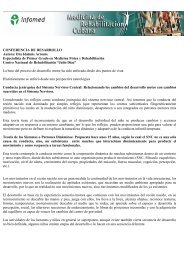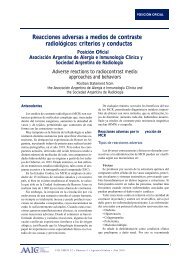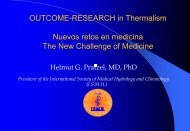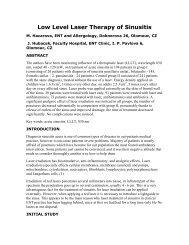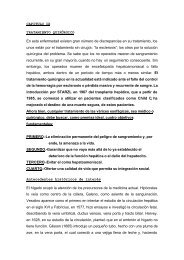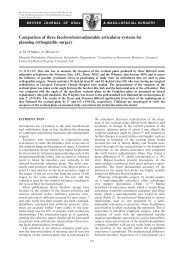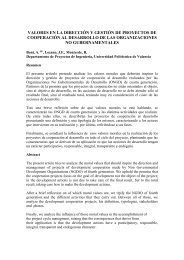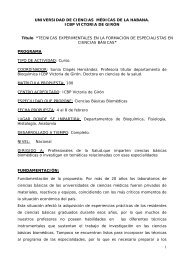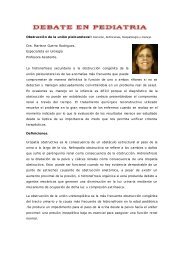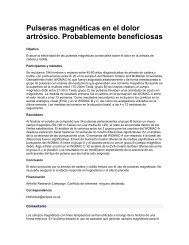Perioperative Anaphylaxis
Perioperative Anaphylaxis
Perioperative Anaphylaxis
You also want an ePaper? Increase the reach of your titles
YUMPU automatically turns print PDFs into web optimized ePapers that Google loves.
<strong>Perioperative</strong> <strong>Anaphylaxis</strong> 441<br />
cross-reactivity between NMBAs. They concluded that the rocuronium ImmunoCAP<br />
constitutes a reliable technique to diagnose rocuronium allergy provided an assayspecific<br />
decision threshold is applied, because these assays reach a sensitivity of<br />
more than 85% and absolute specificity.<br />
Specific IgEs against thiopental, morphine, phenoperidine, and propofol have also<br />
been detected in the serum of sensitized patients using IgE radioimmunoassays. 80,81<br />
The presence of hydrophobic IgE reacting nonspecifically with propofol has been<br />
reported. 82 With respect to latex, a radioallergosorbent test is available. Although it<br />
is considered to be less sensitive than the skin prick test, a 92.8% sensitivity has<br />
been reported. 83<br />
These findings have recently led to limiting the indications for specific IgE assays to<br />
the diagnosis of anaphylaxis to NMBA, thiopental, and latex. 2 These tests are usually<br />
performed several weeks after the reaction but also can be performed at the time of<br />
the reaction. 2,70,71<br />
SKIN TESTING<br />
In most reports, skin tests in association with history remain the mainstay of the diagnosis<br />
of an IgE-mediated reaction. Intradermal skin or prick tests are usually<br />
performed 4 to 6 weeks after a reaction, because, before 4 weeks, the intracellular<br />
stocks of histamine and other mediators are still lower than normal. 84 Skin tests to<br />
NMBAs may remain positive for years later. Ideally, testing should be performed by<br />
a professional experienced in performing and interpreting tests with anesthetic agents<br />
(Table 5). 2<br />
Prick tests and intradermal reactions with dilutions of commercially available drug<br />
preparations are advised. Although highly reliable, skin tests are not infallible. 85 Standardized<br />
procedures and dilutions must be precisely defined for each agent tested to<br />
avoid false-positive results. Control tests using saline (negative control) and codeine<br />
(positive control) must accompany skin tests to determine whether the skin is apt to<br />
release histamine and react to it.<br />
A certain degree of controversy remains as to the maximal concentrations to be<br />
used when sensitization to NMBAs is investigated. 86,87 Detailed recommendations<br />
for skin and intradermal test dilutions of anesthetic drugs including NMBAs have<br />
been proposed by the SFAR and the French Society of Allergology (Societe Française<br />
d’Allergologie et d’Immunologie Clinique) (Table 5). 2 The accuracy of these recommended<br />
maximal concentrations has been confirmed in a prospective study conducted<br />
in 120 healthy volunteers tested with all NMBAs available at increasing<br />
concentration both on the anterior part of the forearm and the back. Results were<br />
similar on both injection sites. 68 Skin tests are interpreted after 15 to 20 minutes.<br />
A prick test is considered positive when the diameter of the wheal is at least equal<br />
to half of that produced by the positive control test and at least 3 mm greater than<br />
the negative control. Intradermal tests are considered positive when the diameter of<br />
the wheal is twice or more the diameter of the injection wheal.<br />
Any drug administered during the perioperative period should be considered as<br />
a potential cause. 61 In addition, because of the frequent but not systematic<br />
cross-reactivity observed with muscle relaxants, all available NMBAs should be<br />
tested. 2,13,64,72 In most cases, patients allergic to one muscle relaxant can be given<br />
another agent chosen on the basis of skin test screening. In our experience, we<br />
suggest that the concentration of muscle relaxant used for skin testing be increased<br />
to a dilution of 10 1 of the commercially available substance tested to reduce falsenegative<br />
results. Furthermore, we recommend leukocyte histamine release or



